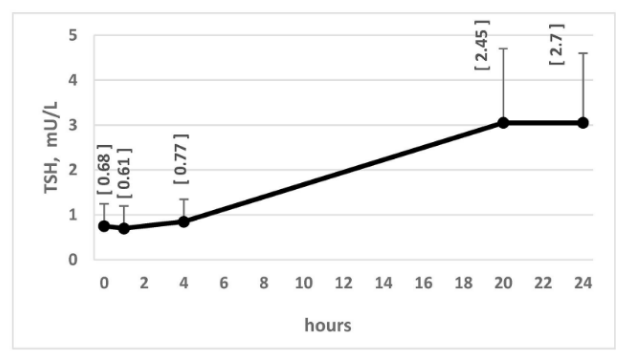An interesting study recently gave us some interesting insight into how the time of a woman’s cycle can affect thyroid test levels.(1) Using 55 women as test subjects, researchers created a situation that mimicked ovulatory estrogen levels. Over the course of the study, it was discovered that when estrogen reached ovulatory levels, the thyroid-regulating hormone TSH levels rose as well.
When the women were at the beginning of their cycles, theirTSH levels averaged at 1.78. At the peak of estrogen (similar to what would occur just prior to ovulation), TSH increased four-fold to 3.30. Additionally, 31 percent of women had a TSH above4.0 during peak estrogen timing.
It should be noted that these women also had an increase in free T3—the active thyroid hormone. This indicates that the TSH was actively stimulating thyroid hormone production as well.
Related post:Natural Treatments for Hashimoto’s Thyroiditis
Why Did These Thyroid Hormone Levels Rise?
Normally, when TSH rises, it means the person is more hypothyroid.This is basically the brain signalling the gland to make more of the hormone. Since the active T3 hormone also rose, it’s quite likely that in this situation, this rise in TSH most likely does not indicate hypothyroidism. Typically, in hypothyroidism cases, free thyroid hormones like T3 and T4 decrease, instead of rising.
This change in TSH occurs because the pituitary cells thatregulate the thyroid (thytrophes) contain estrogen receptors. When estrogen activates them, they respond by making more TSH.
TSH then causes the gland to up-regulate the production of thyroid hormones.
Since free T3 levels increase along with the TSH with this estrogen peak which would normally happen at midcycle, This suggests that the person’s TSH levels shouldn’t be looked at alone as a marker of thyroid function at that time.
When to Test Thyroid Hormone Levels
If ONLY TSH is being tested, it seems optimal to test at the beginning of your cycle when your estrogen levels are low. However, it’s always much better to also have the thyroid hormones fT3 and fT4 tested to get the most accurate picture of how your thyroid is functioning. TSH is produced by the pituitary, not by the thyroid gland.
Should the TSH testing have to happen when you’re at midcycle, ensure that they test fT3 and fT4 as well. If TSH is elevated, it’s important to ask whether T3 and T4 levels are optimal.If anything looks off, it can be repeated again at the beginning of the cycle.
Ultimately, TSH should never be tested alone to assess thyroid function. This is because TSH isn’t a thyroid hormone at all: it’s a pituitary hormone that’s affected by countless different factors.
Related post: Zinc, Selenium and Thyroid Function
A Special Note on Thyroid Hormone Levels and Pregnancy:
During pregnancy, there is also a well-known correlation between the increase in estrogen levels and also the increase in TSH.
There is a difference here, however, since during pregnancy there is a much more prolonged and profound rise in estrogen. There’s also a wide array of other major hormonal changes, such as thyroid-binding globulin (TBG). This binds up the thyroid hormones and stays very high during pregnancy.
This occurs because of its increased synthesis in the liver, as well as increased excretion of TBG.Since TBG binds up hormones like T3 and T4, fewer of them are available to activate receptors for the baby’s development.(2)
There is also an increased amount of iodine excretion in urine, which complicates matters further. All of these factors are why we need to follow the specific ranges for pregnancy very carefully.
Related Post: Guidelines for Thyroid Hormone Testing in Pregnancy
Article References:
- Benvenga, Salvatore et al.Circulating thyrotropin is upregulated by estradiolJournal of Clinical Translational EndocrinologyVolume 11;(11 – 17).
- John H. LazarusThyroid function in pregnancyBritish Medical BulletinVolume 97;(1):137-148.




